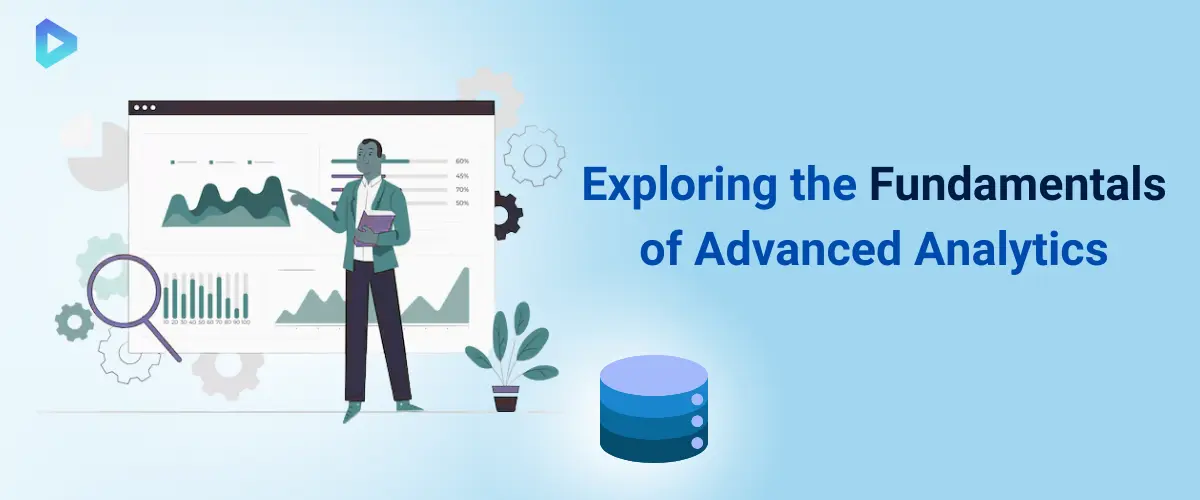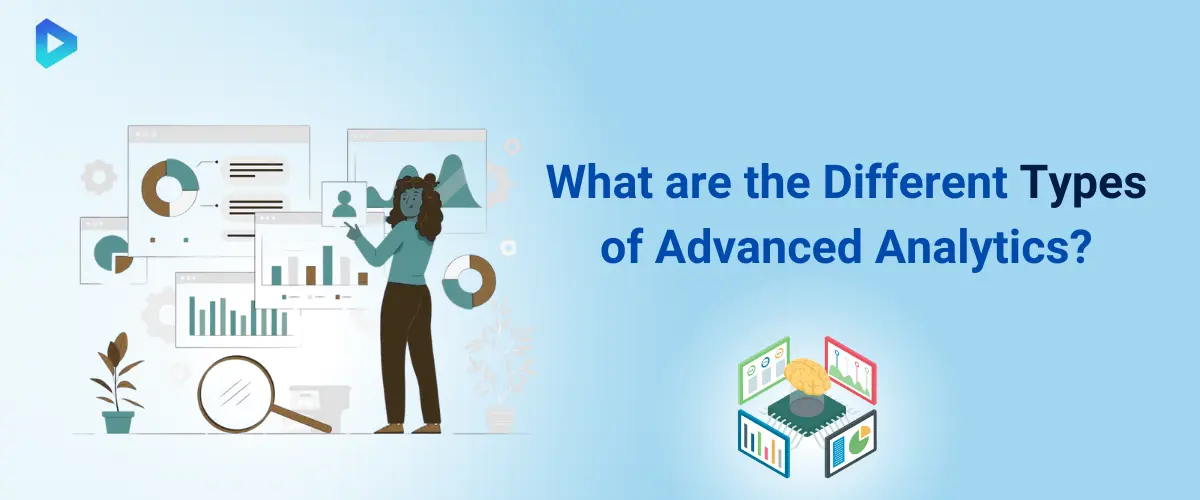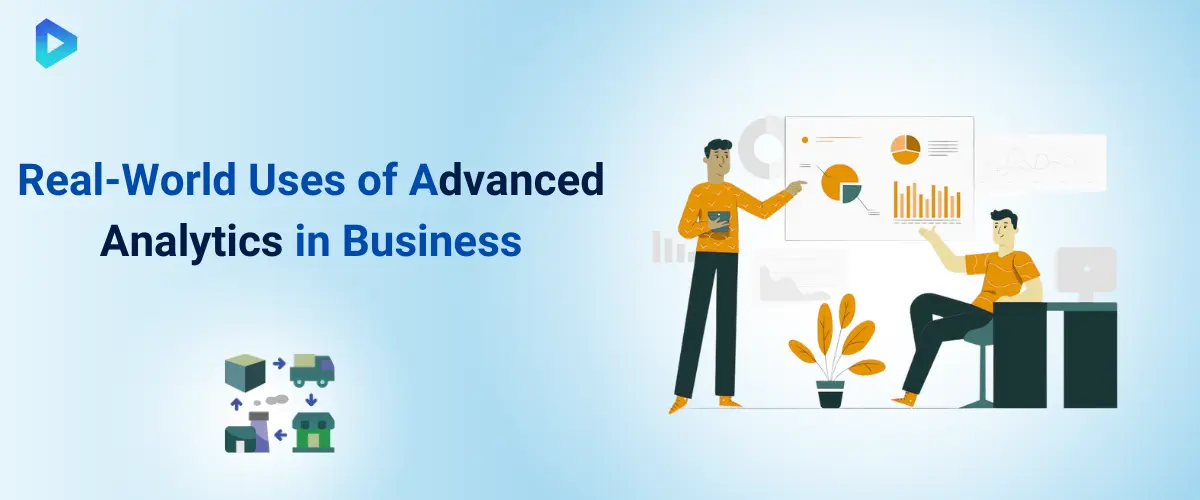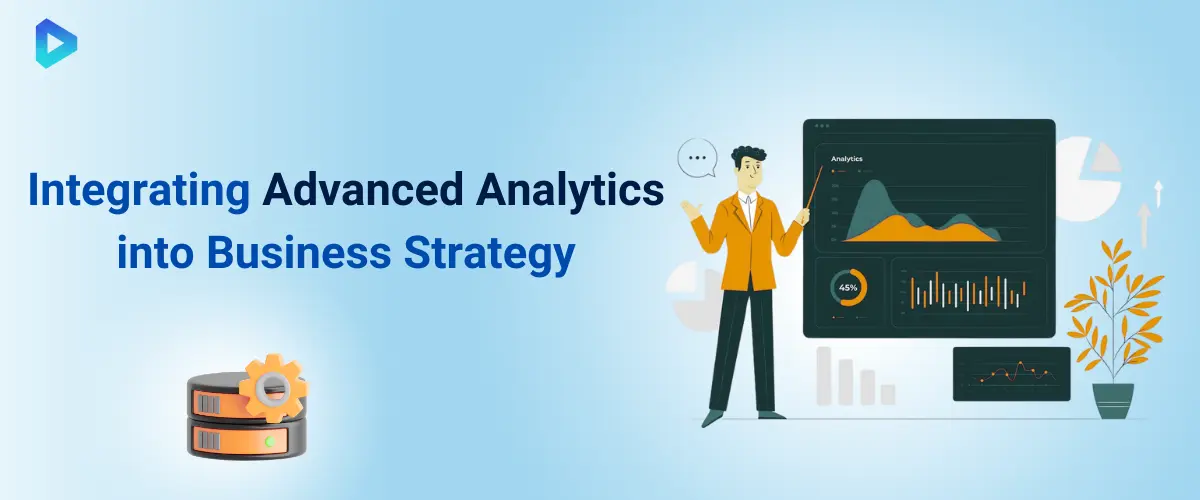From Netflix’s recommendation engine to Amazon’s supply chain optimizations, advanced analytics powers today’s most successful businesses. But what about your enterprise?
Whether you’re in manufacturing, healthcare, or retail, data holds the key to efficiency and innovation. In this blog, we’ll demystify advanced analytics—explaining its core concepts, benefits, and practical steps to implement it.
No matter your industry or data maturity level, you’ll leave with a clear roadmap to start leveraging analytics for smarter decisions and sustainable growth.
What Is Advanced Analytics?
 Advanced analytics transforms raw data into powerful insights for smarter business decisions.
Advanced analytics transforms raw data into powerful insights for smarter business decisions.
Defining Advanced Analytics in Simple Terms
Advanced analytics refers to a set of sophisticated techniques and tools designed to analyze data beyond traditional methods. It encompasses processes like machine learning, predictive modeling, and data mining to uncover patterns, predict future trends, and generate actionable insights.
Unlike basic analytics, which primarily focuses on historical data, advanced analytics aims to provide a forward-looking perspective, enabling businesses to anticipate outcomes and make proactive decisions. This approach allows organizations to harness complex data sets effectively, leading to enhanced operational efficiency and competitive advantage.
For example:
- A retailer uses it to predict next season's top-selling products
- Hospitals analyze patient data to prevent readmissions
- Banks detect fraud patterns in real-time
Unlike simple dashboards, advanced analytics provides actionable "why" and "what-if" insights that drive strategic decisions.
How Does Advanced Analytics Differ from Basic Analytics?
Basic analytics tells you what happened (descriptive). Advanced analytics reveals why it happened (diagnostic) and what will happen next (predictive).
Key differences:
- Basic: Monthly sales reports (historical data)
- Advanced: Predicting which customers will churn (future insights)
- Basic: Static charts
- Advanced: Interactive simulations
While basic analytics looks backward, advanced analytics helps you plan forward with confidence.
Core Components of Advanced Analytics Systems
Modern advanced analytics platforms combine three key elements:
Data Processing:
- Cleans and prepares messy real-world data
- Handles both structured and unstructured data
Modeling Techniques:
- Machine learning algorithms
- Predictive modeling
- Natural language processing
Visualization Tools:
- Interactive dashboards
- Real-time data storytelling
- Customizable reporting
For instance, a manufacturing company might use all three components to predict equipment failures before they happen - saving millions in downtime.
What are the Different Types of Advanced Analytics?
 Advanced analytics comes in several forms, each offering unique ways to extract value from your data.
Advanced analytics comes in several forms, each offering unique ways to extract value from your data.
Predictive Analytics: Forecasting Future Trends
Predictive analytics uses historical data and machine learning to forecast what might happen next. It's like having a crystal ball for your business decisions.
Real-world examples:
- Retailers predicting next season's best-sellers
- Banks assessing loan default risks
- Hospitals forecasting patient admissions
Key benefits:
- Reduces uncertainty in planning
- Identifies opportunities before competitors
- Optimizes inventory and staffing
For instance, an e-commerce store might use predictive analytics to stock up on umbrellas before the rainy season hits.
Prescriptive Analytics: Data-Driven Decision Making
Prescriptive analytics goes beyond prediction to recommend specific actions. It answers "What should we do?" rather than just "What will happen?"
Common applications:
- Route optimization for delivery trucks
- Dynamic pricing for airlines/hotels
- Personalized medicine treatment plans
Why does it matter?
- Suggests the best course of action
- Considers multiple possible outcomes
- Automates complex decision processes
Imagine a logistics company using prescriptive analytics to determine the most fuel-efficient delivery routes in real-time.
Descriptive vs. Diagnostic Analytics Explained
While both look backward, they serve different purposes:
Descriptive Analytics (What happened?)
- Tracks KPIs and metrics
- Creates reports and dashboards
- Example: Monthly sales performance
Diagnostic Analytics (Why did it happen?)
- Identifies root causes
- Uses drill-down techniques
- Example: Analyzing a sales drop
Key differences:
- Descriptive shows the "what"
- Diagnosis reveals the "why"
- Together, they form an analytics foundation
A marketing team might use descriptive analytics to see campaign results, then diagnostic to understand which elements drove success.
Applications of Advanced Analytics in Enterprises
 Advanced analytics is revolutionizing how businesses operate, turning data into strategic advantages.
Advanced analytics is revolutionizing how businesses operate, turning data into strategic advantages.
Where Advanced Analytics Adds Real Business Value?
Advanced analytics creates tangible value by solving specific business challenges. In marketing, it predicts which customers are most likely to convert, allowing for smarter ad spending.
Operations teams use it to anticipate equipment failures before they occur, minimizing downtime. Finance departments leverage it to detect fraudulent transactions in real-time.
Key impact areas:
- Customer retention (predicting churn risks)
- Supply chain optimization (inventory forecasting)
- Pricing strategies (dynamic pricing models)
For instance, a retail chain used predictive analytics to reduce overstock by 18% while improving product availability.
Key Enterprise Functions Using Advanced Analytics
Nearly every department benefits from advanced analytics:
- Sales: Identifies high-probability leads and optimal contact times
- HR: Predicts employee turnover and improves hiring
- Customer Service: Anticipates support needs before they arise
Implementation approach:
- Begin with functions generating the most data
- Focus on decisions with measurable outcomes
- Choose user-friendly tools that teams will adopt
A logistics company improved delivery times by 25% using route optimization analytics.
Small Wins That Build Analytics Momentum Early
Successful analytics adoption starts with quick, visible wins:
- Automating weekly sales reports (saves 15+ hours)
- Predicting top-selling products for one category
- Identifying the 20% of customers driving 80% of revenue
Why this matters:
- Demonstrates quick ROI
- Builds confidence across teams
- Creates internal success stories
One manufacturer started with predictive maintenance on just two machines, then expanded after seeing a 30% reduction in downtime.
Why Advanced Analytics Is Important for Growth?

Advanced analytics transforms data into your most powerful growth engine.
Turning Raw Data into Meaningful Business Insights
Advanced analytics converts overwhelming data into clear, actionable insights. Where spreadsheets show numbers, analytics reveals patterns - like which customers will likely leave, or which products will sell best next quarter.
Key transformations:
- Customer data → Predicts buying behaviors
- Operational metrics → Identifies efficiency gaps
- Market trends → Spots emerging opportunities
Example: A coffee chain analyzed purchase patterns to discover their 3 pm latte rush, allowing better staff scheduling.
Making Faster, Smarter, and More Confident Decisions
Analytics replaces guesswork with evidence-based choices. Teams can:
- Respond to market changes in real-time
- Allocate budgets to the highest-return initiatives
- Test scenarios before committing resources
Impact examples:
- 40% faster product development cycles
- 25% reduction in wasted marketing spend
- 15% improvement in customer retention
It's like having a GPS for business decisions instead of driving blind.
Aligning Analytics with Your Strategic Objectives
The best analytics directly support your business goals. For:
Revenue Growth:
- Identify high-value customer segments
- Optimize pricing strategies
Cost Reduction:
- Predict maintenance needs
- Streamline supply chains
Customer Experience:
- Personalize recommendations
- Anticipate service issues
A fashion retailer aligned analytics with their sustainability goals, reducing fabric waste by 22% through predictive inventory models.
Core Advantages of Using Advanced Analytics
 Advanced analytics delivers tangible benefits that directly impact your bottom line.
Advanced analytics delivers tangible benefits that directly impact your bottom line.
From Efficiency Gains to Revenue Opportunities
Advanced analytics unlocks both cost savings and new revenue streams by revealing hidden opportunities in your data. Marketing teams use it to identify high-value customer segments for targeted campaigns, while sales departments prioritize leads with the highest conversion potential.
Key Benefits:
- 30-50% faster processing of key business operations
- 15-25% increase in cross-sell success rates
- Identification of untapped market segments
Example: A mid-sized retailer discovered a 22% revenue opportunity by analyzing purchase patterns and adjusting their product mix accordingly.
Reducing Costs with Predictive Modeling
Predictive analytics helps businesses slash unnecessary expenses through smarter forecasting and planning. It enables:
- Optimal inventory levels (reducing carrying costs by 20-35%)
- Preventive maintenance (cutting equipment downtime by 40-60%)
- Fraud detection (decreasing losses by 25-50%)
A logistics company saved $2.3M annually by using predictive models to optimize its delivery routes and fuel consumption.
Enhancing Accuracy in Business Forecasting
Advanced analytics transforms guesswork into precise projections by:
- Incorporating hundreds of variables simultaneously
- Continuously learning from new data
- Simulating multiple scenarios
Results you can expect:
- 90% + accuracy in demand forecasting
- 60% reduction in forecasting time
- Real-time adjustment capabilities
An electronics manufacturer improved their production planning accuracy by 38%, dramatically reducing both overstock and stockouts.
Common Use Cases of Advanced Analytics Today
 Advanced analytics is transforming industries by solving real-world business challenges.
Advanced analytics is transforming industries by solving real-world business challenges.
Retail: Personalizing Customer Experiences
Retailers utilize advanced analytics to create personalized shopping experiences that enhance sales and loyalty. By analyzing purchase history, browsing behavior, and demographic data, stores can:
- Recommend products with 85% accuracy
- Send personalized promotions at optimal times
- Adjust inventory based on local preferences
Example: A clothing brand increased online conversions by 35% using AI-powered size recommendations that reduced returns.
Healthcare: Improving Patient Outcomes
Hospitals leverage predictive analytics to enhance care while reducing costs. Key applications include:
- Early identification of at-risk patients
- Optimal treatment plan recommendations
- Hospital readmission prediction (lowering rates by 20-30%)
A health system prevented 300+ unnecessary readmissions annually by flagging high-risk patients for follow-up care.
Finance: Fraud Detection and Prevention
- Banks and fintechs use machine learning to:
- Detect suspicious transactions in milliseconds
- Reduce false positives by 40-60%
- Continuously adapt to new fraud patterns
One credit card company stopped $50M in annual fraud while improving legitimate transaction approval rates.



Let's Discuss Your Idea!
Send us your request using the form below.
Contact Info
Our contacts
Thank You!
We will respond to you within 24 hours.